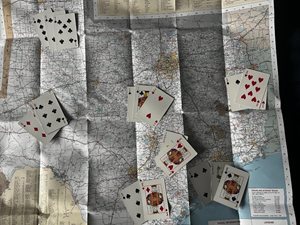
Last week, I talked about the number of crashes I saw on my route. The trick to staying out of these traffic incidents is to have good risk management skills. On our 2022 Cascadia, we have disk brakes, Detroit Assurance 5.0 Collision Mitigation System, and Lane Keep Assist. Detroit Assurance provides optimum on-road safety. With a bumper-mounted radar and the optional windshield-mounted camera, Detroit Assurance communicates information to the truck’s brakes, engine, and transmission in real-time to help mitigate collisions and enhance driver safety.
I use Detroit Assurance as a tool to make myself a more alert driver. If these safety systems are engaging or warning me of a problem, it means that I am driving inappropriately for maximum safety. The key to operating this safety system is much like walking a loyal dog. I must stay a step ahead of its actions so that I can stay in control. Yet still, even when we take all the precautions when we’re driving, it seems we are gambling with our safety.
There are many practices that I employ to put the gambling odds in my favor. The main one is trip planning. Trip planning sounds overly simple. Yet it is a complex task that I must perform to minimize traveling through high-risk congested areas during peak activity levels. Regularly, it comes down to identifying which areas are the most likely to cause the highest potential risks associated with dense traffic periods, and whether I should take a break to avoid getting stuck in that traffic due to crashes. The GPS will alert me of potential added minutes to my travel time on my route. Sometimes though, my GPS will “cry wolf”. It has been known to advise of previously cleared traffic that was left in the queue. Because of this, sometimes false information is given to me, and I find myself double-checking the traffic with Google Maps and other helpful apps before I decide to continue on my run.
There are tools that we can use to lessen our exposure to these higher-risk travel periods. One method I use often is the split sleeper logbook provision, which enables me to take breaks varying in length from as short as two hours, to as long as eight hours. Employing this technique properly allows me to travel through these metropolitan areas during a period of less risk. Doing this also enables me to preserve my available hours of service for generating revenue, instead of contributing to the already dense traffic of an urban area. I do have an advantage in that I run regular routes, so I am familiar with the locations of truck stops and available parking areas where I can wait out traffic if I need to. Most times, I know when I can hold my hand, or fold and take a break.
Another deck of cards that I have been playing with lately has been using some of the lesser-used US, state, and county routes to completely miss certain high-density urban areas. I have found that taking the rural routes has neither delayed nor saved me time, but I find them to be more relaxing than staying on the heavily transited major highways.
A third technique that I do not use as often anymore, due to where my routes are, is to take a break and park during the beginning of a snowstorm. Knowing where the storm will hit, and how long it will last, helps quite a bit here. Somehow it is during this time that motorists are rushing around to stock up on milk, bread, water, and toilet paper. I have found that many irrational driving decisions seem to come during the initial part of a snowstorm.
It is hard to beat the house that is dealing with the cards. However, it is to our benefit, as professional drivers, to find ways to make the most out of the cards we have been dealt and put the odds in our favor to have a safe journey and arrive at our desired destination.
